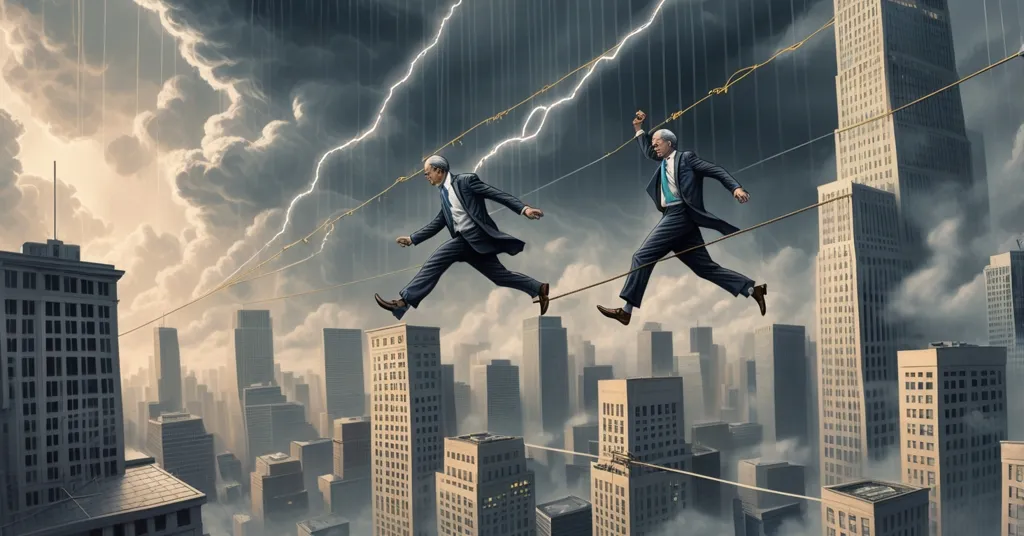Federal Reserve Rates Unchanged: Bitcoin and Crypto at a 2024 Crossroads

Federal Reserve Holds Rates Steady: Bitcoin and Crypto Face a Double-Edged Sword in 2024
The Federal Reserve’s latest decision to keep interest rates unchanged at 4.25% to 4.5% is hardly a shocker, matching Wall Street’s expectations, but it’s a loud signal of the economic tightrope the U.S. is walking. With inflation creeping up, growth forecasts slashed, and political heat from President Donald Trump, the central bank’s cautious stance ripples far beyond traditional markets—straight into the heart of Bitcoin and cryptocurrency ecosystems.
- Rate Hold: Federal funds rate stays at 4.25%-4.5%, unchanged since December 2024.
- Economic Strain: GDP growth for 2024 cut to 1.4%, inflation up to 3%, unemployment rising to 4.5%.
- Crypto Crossroads: High rates squeeze risk assets like Bitcoin, yet inflation and debt woes could fuel decentralized appeal.
The Fed’s Numbers: A Stagflation Scare
The Fed’s decision to hold steady isn’t just a pause—it’s a neon sign flashing caution. They’re projecting only two rate cuts by the end of 2025, with a mere 1% total reduction expected through 2027. For the uninitiated, the federal funds rate is the interest banks charge each other for overnight loans, and it sets the tone for borrowing costs across the economy. Keeping it high means tighter money for everyone, from businesses to speculators. Meanwhile, internal cracks are showing: seven of 19 Federal Open Market Committee (FOMC) members now oppose any cuts next year, up from four in March. Why the dissent? They’re spooked by stagflation—a nasty combo of stagnant growth and rising prices, like a car stuck in mud with the engine overheating. You can’t move forward, and the costs just keep climbing.
The data backs up the worry. GDP growth for 2024 has been downgraded to 1.4%, a drop of 0.3 points from prior estimates. Inflation, measured by the Personal Consumption Expenditures (PCE) index—a key metric the Fed watches for price changes—is now forecast at 3%, with core PCE (excluding volatile food and energy) at 3.1%, both up 0.3 points. Unemployment is expected to edge up to 4.5% from 4.4%. These aren’t abstract figures; they mean slower hiring, pricier goods, and a real squeeze on households. The Fed’s own words hint at the bind they’re in, claiming the economy grows at a “solid pace” with joblessness “low” and inflation “somewhat elevated,” while admitting they’re keenly aware of risks to their dual mandate—keeping prices stable and jobs plentiful. For more on the Fed’s stance, check the recent announcement on unchanged rates.
Political Firestorm: Trump vs. Powell
Enter the political drama, stage right. President Donald Trump has been relentless, hammering Fed Chair Jerome Powell for not slashing rates. With a national debt ballooning to $36 trillion and a federal deficit of $2 trillion (over 6% of GDP), the U.S. is hemorrhaging $1.2 trillion annually just on interest payments. Trump’s logic is blunt: lower rates mean cheaper debt servicing. He’s not whispering this behind closed doors either.
“The fed funds rate should be at least two points lower.” – Donald Trump
This isn’t just a policy quibble—it’s a direct jab at the Fed’s independence, a sacred cow of modern economics meant to shield monetary decisions from political whims. Powell’s response? A stoic insistence on data over drama, suggesting they’ll “wait a couple of months” for clarity on inflation and other pressures. But the tension is palpable. Experts like Daniel Hornung, a former deputy director at the National Economic Council, argue that without Trump’s trade policy chaos, the Fed might already be easing rates. Instead, they’re stuck in a bind, watching for sticky price hikes that could upend their plans. Learn more about Trump’s ongoing criticism of the Fed and its broader implications.
Trade Wars and Geopolitical Blind Spots
Trump’s tariffs are a wildcard in this mess. With average duties at 14%, and punishing rates of 50% on steel and aluminum plus 25% on cars from Canada and Mexico, these trade barriers are stoking fears of higher prices and slower growth. Trump shrugs off the impact, claiming there’s “no inflation” from his policies, but economists like Benjamin Shoesmith from KPMG warn that costs will eventually hit consumers. Businesses might be eating the extra charges for now, using inventory buffers, but that dam won’t hold forever.
Then there’s the Fed’s glaring silence on geopolitical risks. The Israel-Iran conflict, a simmering powder keg in the Middle East, didn’t even get a footnote in their statement. Why should you care? A flare-up could spike oil prices, with every $10 jump per barrel potentially adding 0.5% to inflation, per Ryan Sweet of Oxford Economics. In a nightmare scenario—say, a closure of the Strait of Hormuz, a critical oil chokepoint—crude could hit $120 per barrel, driving the Consumer Price Index to 5%. It’s like ignoring a gas leak in your house because the stove still works. The Fed’s oversight here, whether sloppy or strategic, leaves a gaping hole in their risk assessment. Explore how the Israel-Iran tensions could impact energy costs and inflation.
Bitcoin’s Hedge Narrative in Focus
So, how does this economic quagmire affect Bitcoin and the broader crypto market? High interest rates mean tighter liquidity—bad news for risk assets like cryptocurrencies. When borrowing costs stay elevated, speculative investments often take a backseat. Bitcoin miners, already grappling with energy expenses, could get hammered if geopolitical tensions push oil prices higher. Historically, post-2022 rate hikes saw Bitcoin’s price struggle under similar pressures, dropping from $69,000 in late 2021 to below $20,000 by mid-2022 as the Fed tightened the screws. Today’s environment isn’t much kinder for those betting on a quick rally. For a deeper look, see this analysis of Bitcoin market trends tied to Fed decisions.
But there’s a flip side, and it’s why Bitcoin maximalists are still grinning through the gloom. With inflation stubbornly above the Fed’s 2% target and a national debt that’s basically a fiscal black hole, the case for Bitcoin as a decentralized store of value gets louder. When fiat currencies are under siege from trade wars, deficits, and political meddling, a censorship-resistant asset with a fixed supply of 21 million coins starts looking bloody compelling. Think of it as digital gold for a stagflationary era—much like how gold soared in the 1970s when the U.S. economy was in a similar rut. If trust in centralized systems keeps eroding, Bitcoin could catch a bid as a hedge against fiat devaluation. Community discussions on Bitcoin’s response to Fed rate policies offer some interesting perspectives.
Stablecoins and Trade Disruptions
Bitcoin isn’t the only player in this game. Stablecoins—cryptocurrencies pegged to assets like the U.S. dollar for price stability, unlike Bitcoin’s wild swings—could see a surge if tariffs keep disrupting cross-border trade. Projects like Tether (USDT) and USD Coin (USDC) are already used by millions for payments and remittances, offering a workaround when traditional finance gets bogged down by duties or currency volatility. If Trump’s trade policies push supply chain costs higher, businesses and individuals might lean harder on these digital dollars to settle transactions without the friction of fiat systems. It’s a niche Bitcoin doesn’t fill, nor should it, given its focus on scarcity over utility as a medium of exchange. Read more about the role of stablecoins in high-rate environments.
Risks to Crypto in a Rate-Hike Scenario
Let’s not drown in optimism, though. The Fed’s indecision could turn ugly fast. If inflation spikes further—whether from tariffs or an energy crisis—they might be forced to hike rates again, not just hold them. That’s a gut punch to risk assets across the board, crypto included. Bitcoin isn’t immune to market sentiment; during the 2022 bear market, it cratered alongside stocks as liquidity dried up. Add in the specter of regulatory crackdowns—governments often tighten the leash during economic crises—and the hedge narrative starts looking shaky. Plus, if unemployment climbs and consumer confidence tanks, even die-hard HODLers might liquidate holdings to cover bills. Crypto’s no magic bullet when the whole system’s wobbling. Curious about broader impacts? Check out this discussion on how interest rates influence crypto prices.
Key Takeaways and Burning Questions
- Why is the Fed keeping rates at 4.25%-4.5%?
They’re wrestling with stagflation fears—1.4% GDP growth and 3% inflation—plus uncertainty from tariffs and geopolitical risks, opting for a wait-and-see stance. - What’s driving dissent within the Federal Reserve?
Seven of 19 FOMC members oppose 2025 rate cuts, prioritizing inflation control over economic stimulus, signaling a split on how to handle mixed economic signals. - How does Trump’s pressure challenge the Fed?
His demand for lower rates to cut debt costs ($1.2 trillion annually on $36 trillion debt) tests the Fed’s independence, though Powell sticks to data over politics. - Why does the Israel-Iran conflict matter to economic policy?
Unaddressed tensions could spike oil prices to $120/barrel, pushing inflation to 5%, forcing the Fed into tougher rate decisions that ripple to all markets. - What’s the Bitcoin and crypto market outlook amid these conditions?
High rates could dampen enthusiasm for risk assets like Bitcoin due to tight liquidity, but persistent inflation and fiat stress might boost appeal as a decentralized hedge. - Can altcoins and stablecoins play a role in this mess?
Absolutely—stablecoins like USDT and USDC could ease trade friction from tariffs, while DeFi on Ethereum might offer liquidity as traditional credit tightens.
Decentralization’s Moment—or Mirage?
Stepping back, the Fed’s tightrope walk mirrors deeper cracks in centralized finance. A monstrous debt, trade policies stoking price fears, and ignored global flashpoints aren’t just numbers—they’re proof the status quo is fragile. For Bitcoin purists, this is a rallying cry: trust in institutions is a house of cards, and decentralized systems are the escape hatch. Yet, let’s not pretend altcoins and other blockchains like Ethereum don’t matter. DeFi protocols can provide lending when banks won’t, and stablecoins can bridge trade gaps Bitcoin isn’t built for. The crypto ecosystem isn’t a monolith—it’s a toolkit, and each piece has its purpose.
Historically, Fed policies have swayed crypto markets hard. Look at 2020: quantitative easing and near-zero rates fueled Bitcoin’s run to $69,000 as liquidity flooded risk assets. Today’s high-rate environment is a stark contrast, but the underlying distrust in fiat—amplified by political noise and economic missteps—still echoes that era’s push for alternatives. Will this chaos drive more investors to decentralized havens, or are we overhyping crypto’s shield against global storms? One thing’s clear: the future of money isn’t being decided just in Fed boardrooms—it’s being coded, mined, and traded in the blockchain trenches. And that’s a fight worth watching. For insights into Powell’s latest comments on stagflation and inflation, see the Fed’s December 2023 rate decision statement.



